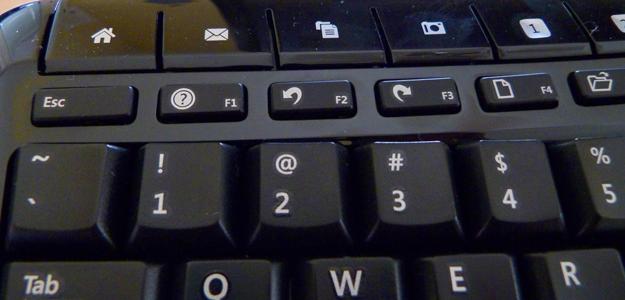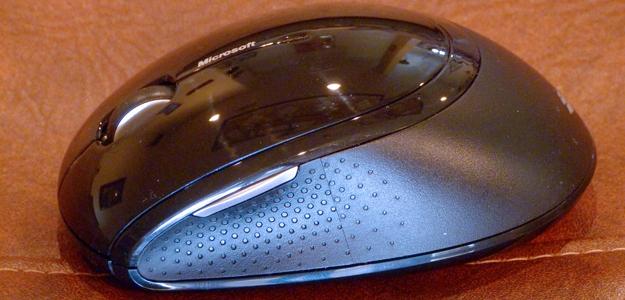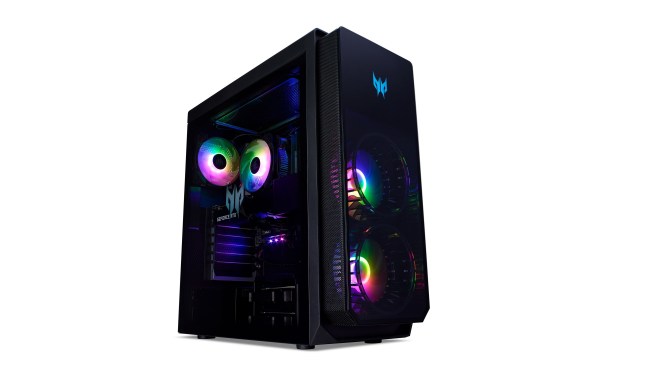- Very good tactile feedback
- Comfortable
- Lots of programmable buttons
- Oversized USB dongle
- Too-small Function keys
- No index option for mouse scroll wheel
Currently celebrating its 30th anniversary, Microsoft’s hardware division has a wealth of experience to draw from when it comes to designing keyboards, mice, and other peripherals. There’s ample evidence of that design experience in the Wireless Comfort Desktop 5000.
This isn’t the fanciest mouse-and-keyboard combo on the market, but it has well-placed buttons for most of the common tasks you’ll use your PC for, the primary keys provide very good tactile feedback, it’s easily programmed, and most importantly, it felt good under our hands. A large wrist rest, covered in diamond-patterned rubber, accounts for about 25 percent of the lower horizontal surface area, but our typing style kept our wrists elevated above it. Had we wanted to, we could have inserted a pair of rubber plugs into the bottom of the keyboard beneath the wrist rest to elevate it, but we elected to use these under the top of the keyboard because we prefer to type with the keyboard angled up, not down. Although the plugs provide only one height choice, they’re vastly superior to the flimsy plastic legs that flip out from the bottom of most keyboards.
Ergonomic keyboards — with their wavy designs — seem to have fallen out of favor these days, perhaps because gamers demand straight planks. The letter keys on this model follow a gentle curve, with the home row from A through F curving down toward the wrist rest, and the home row from J to the Enter key curving up and away from it. The layout felt very natural to us, and we were able to type rapidly with accuracy, although we had to stretch just a bit to reach the T and Y keys. The other home row keys that your fingers don’t sit on at rest — the G, H, B, and N keys — are slightly oversized, rendering them easier to find with your index finger.
The primary letter keys have just the right amount of travel: not too deep, not too shallow, and with just enough resistance that you can rest your fingertips on them without pushing them down unintentionally. This isn’t a gaming keyboard, so there are no buttons dedicated to game functions, but we had no problem playing games on it, including The Walking Dead. Some of us tend to pound the keys when we’re writing, and even though this keyboard is outfitted with membrane switches, such aggressive typing produced a surprisingly loud click, followed by a dull thud when the key bottomed out; some people found it a bit annoying.

Programmable keys and buttons
You can program any of these keys, as well as a larger set of buttons above the Function keys, to perform almost any function you like using Microsoft’s IntelliType Pro software. As you might expect, many of these buttons are programmed at the factory to work with Microsoft programs, such as Word, Excel, and Outlook, but it’s easy to reassign them to work with alternative programs.
The keyboard doesn’t have any LEDs to indicate that Caps Lock and Num Lock are engaged, probably to preserve battery power (the mouse and keyboard operate on two AA batteries each). The USB dongle for controlling the two peripherals is absolutely huge compared to the tiny dongle that Logitech supplies with its wireless keyboards and mice these days. Use it with a laptop and you’ll need to unplug for travel, lest it break off and damage your laptop’s USB port as you shove it in your bag. Fortunately, the dongle can be attached to the bottom of the mouse for transport, so it doesn’t get lost. Snap it in place and it will conveniently depress a button to turn the mouse off. The keyboard, however, doesn’t have a power button.
The mouse
The Wireless Mouse 5000 is a straightforward, ambidextrous design with the usual left and right buttons on top, a scroll wheel with a third button and left-right tilt, and two additional buttons on the left and right sides. The rubber-coated wheel rolls freely, without providing the option of precision indexing. The sides where you grip the mouse with your thumb and ringer are indented and covered with a dimpled rubber surface. The top of the mouse, including the buttons, are a glossy black plastic.

Conclusion
The Wireless Comfort 5000 Desktop largely lives up to its promise. The keyboard and mouse are very comfortable to use, and the keyboard provides plenty of one-touch functions for managing your applications. It’s not equipped with informative LEDs, nor does it have convenient features such as audio jacks or a USB hub; but you’re just not going to find such things on a wireless setup. There’s no excusing the too-small F keys, however, and the too-large USB dongle is a genuine pain. The mouse is unremarkable aside from its ability to track on almost any surface, which is great when you’re traveling and don’t always have the ideal workspace.
Highs
- Very good tactile feedback
- Comfortable
- Lots of programmable buttons
Lows
- Oversized USB dongle
- Too-small Function keys
- No index option for mouse scroll wheel




